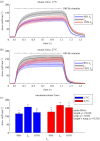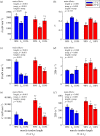Myosin cross-bridge kinetics slow at longer muscle lengths during isometric contractions in intact soleus from mice
- PMID: 33975478
- PMCID: PMC8190544
- DOI: 10.1098/rspb.2020.2895
Myosin cross-bridge kinetics slow at longer muscle lengths during isometric contractions in intact soleus from mice
Abstract
Muscle contraction results from force-generating cross-bridge interactions between myosin and actin. Cross-bridge cycling kinetics underlie fundamental contractile properties, such as active force production and energy utilization. Factors that influence cross-bridge kinetics at the molecular level propagate through the sarcomeres, cells and tissue to modulate whole-muscle function. Conversely, movement and changes in the muscle length can influence cross-bridge kinetics on the molecular level. Reduced, single-molecule and single-fibre experiments have shown that increasing the strain on cross-bridges may slow their cycling rate and prolong their attachment duration. However, whether these strain-dependent cycling mechanisms persist in the intact muscle tissue, which encompasses more complex organization and passive elements, remains unclear. To investigate this multi-scale relationship, we adapted traditional step-stretch protocols for use with mouse soleus muscle during isometric tetanic contractions, enabling novel estimates of length-dependent cross-bridge kinetics in the intact skeletal muscle. Compared to rates at the optimal muscle length (Lo), we found that cross-bridge detachment rates increased by approximately 20% at 90% of Lo (shorter) and decreased by approximately 20% at 110% of Lo (longer). These data indicate that cross-bridge kinetics vary with whole-muscle length during intact, isometric contraction, which could intrinsically modulate force generation and energetics, and suggests a multi-scale feedback pathway between whole-muscle function and cross-bridge activity.
Keywords: myosin cross-bridges intact muscle.
Figures






Similar articles
-
Myosin MgADP Release Rate Decreases as Sarcomere Length Increases in Skinned Rat Soleus Muscle Fibers.Biophys J. 2016 Nov 1;111(9):2011-2023. doi: 10.1016/j.bpj.2016.09.024. Biophys J. 2016. PMID: 27806282 Free PMC article.
-
Effect of active shortening and stretching on the rate of force re-development in rabbit psoas muscle fibres.J Exp Biol. 2022 Nov 15;225(22):jeb244703. doi: 10.1242/jeb.244703. Epub 2022 Nov 18. J Exp Biol. 2022. PMID: 36268629
-
Cross-bridge cooperativity during isometric contraction and unloaded shortening of skeletal muscle.J Muscle Res Cell Motil. 2001;22(5):415-23. doi: 10.1023/a:1014572003361. J Muscle Res Cell Motil. 2001. PMID: 11964067
-
Current Understanding of Residual Force Enhancement: Cross-Bridge Component and Non-Cross-Bridge Component.Int J Mol Sci. 2019 Nov 4;20(21):5479. doi: 10.3390/ijms20215479. Int J Mol Sci. 2019. PMID: 31689920 Free PMC article. Review.
-
Characterization of cross-bridge elasticity and kinetics of cross-bridge cycling during force development in single smooth muscle cells.J Gen Physiol. 1988 Jun;91(6):761-79. doi: 10.1085/jgp.91.6.761. J Gen Physiol. 1988. PMID: 3047311 Free PMC article. Review.
Cited by
-
Supplementation with Live and Heat-Treated Lacticaseibacillus paracasei NB23 Enhances Endurance and Attenuates Exercise-Induced Fatigue in Mice.Nutrients. 2025 Aug 7;17(15):2568. doi: 10.3390/nu17152568. Nutrients. 2025. PMID: 40806152 Free PMC article.
-
Understanding altered contractile properties in advanced age: insights from a systematic muscle modelling approach.Biomech Model Mechanobiol. 2023 Feb;22(1):309-337. doi: 10.1007/s10237-022-01651-9. Epub 2022 Nov 6. Biomech Model Mechanobiol. 2023. PMID: 36335506 Free PMC article.
-
Multi-scale modeling and simulation of skeletal muscles with different fatigue degrees based on microphysiology.Sci Rep. 2025 Mar 31;15(1):11020. doi: 10.1038/s41598-025-87443-4. Sci Rep. 2025. PMID: 40164674 Free PMC article.
References
Publication types
MeSH terms
Substances
Associated data
Grants and funding
LinkOut - more resources
Full Text Sources
Other Literature Sources

